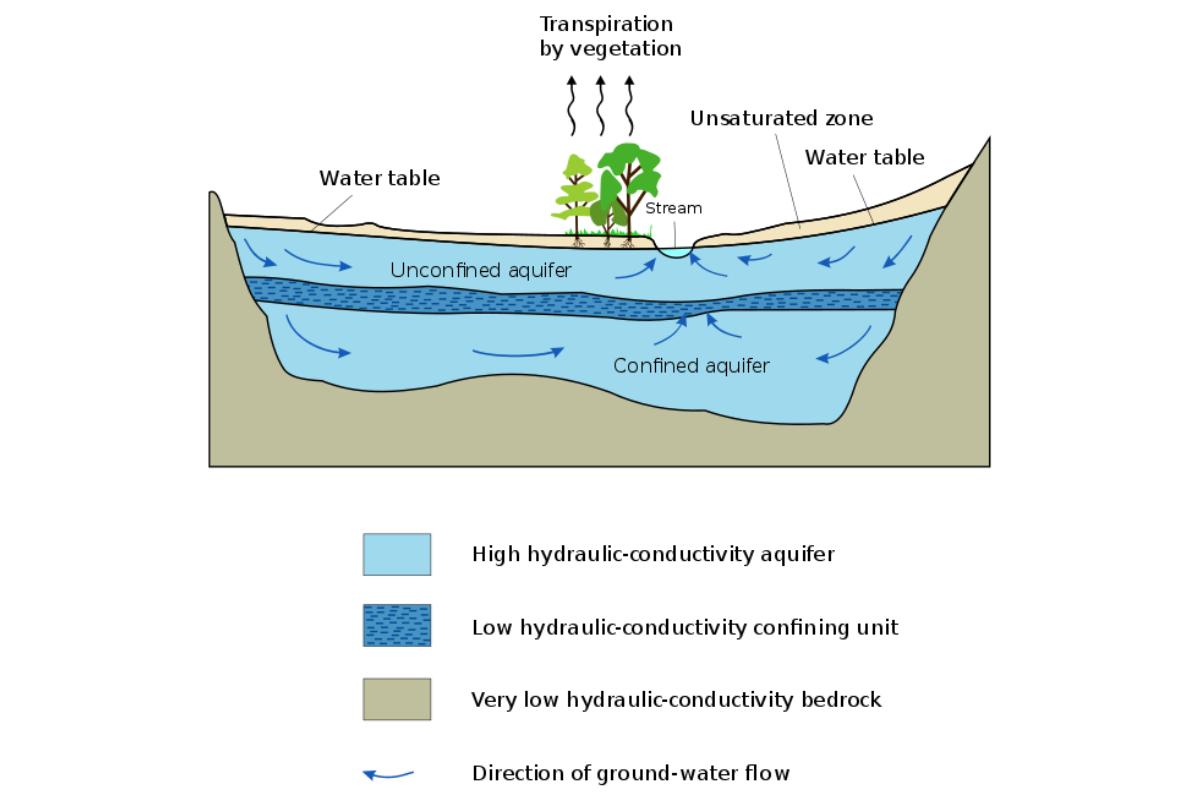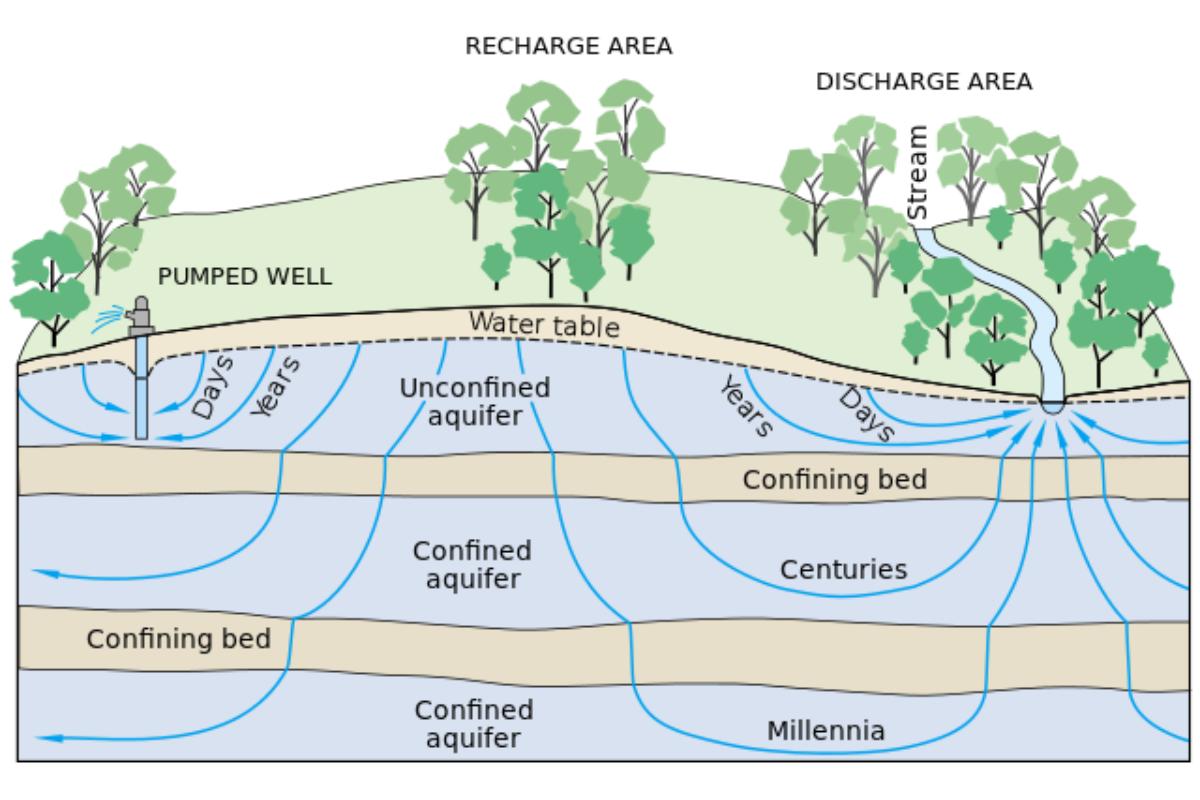Types of Aquifers - Examples With Diagrams


All types of aquifers are important for the water cycle below the Earth's surface, but the different types affects their function. For this part of the water cycle, rainwater infiltrates the ground, occupying pores and cracks in the subsoil, giving rise to underground runoff. Water is stored in aquifers and can be exploited by humans for various uses. The lack of control over these collection activities generates great pressure on these formations and their functioning, so that the natural recharge of the aquifers can be modified. This changes the spatio-temporal patterns of availability of water resources. To avoid these impacts, it is important to know the dynamics and characteristics of these water storage systems.
In this thedailyECO article, you can discover the different types of aquifers. We provide examples with diagrams of these aquifer types to help you better understand how each one functions.
What is an aquifer?
Aquifers are geological formations with hydraulic properties that allow the storage and free transmission of water through their pores or cracks. The primary function of an aquifer is to store, transmit and provide access to groundwater. It acts as a natural reservoir, holding vast quantities of fresh water resources that can be tapped for various uses, including drinking water, irrigation and industrial purposes.
Aquifers also play a crucial role in maintaining the flow of springs, rivers and wetlands by releasing water into surface water bodies through natural discharge. Learn more about how aquifers influence how wetlands are created.
While different types of aquifers can vary, some of the parts of aquifers include:
- Porous rock or sediment: the primary component of an aquifer is the porous rock or sediment, such as sand, gravel or fractured rock. This material acts as a reservoir to store groundwater. The open spaces between particles or fractures in the rock allow water to flow and be stored.
- Saturated zone: this is the region within the porous rock where all available spaces are filled with water. It represents the stored groundwater that is readily accessible.
- Unsaturated zone: above the saturated zone, there is an unsaturated or vadose zone where open spaces in the rock contain both air and water. The water in this zone is typically held in the rock by capillary forces and is less accessible for extraction.
- Water table: the water table is the upper surface of the saturated zone. It represents the boundary between the unsaturated and saturated zones. The depth of the water table can fluctuate due to seasonal variations and groundwater pumping.
- Recharge area: this is the location where water infiltrates the ground surface to replenish the aquifer. It is often associated with areas where precipitation or surface water percolates into the ground. You can see an example of how the recharge works in the diagram below.
- Confining layer or aquitard: in some cases, aquifers are separated from each other or from the land surface by a confining layer, also known as an aquitard. Aquitards have low permeability and restrict the movement of water, helping to confine the aquifer below.
- Aquifer boundaries: aquifers have boundaries that define their extent. These boundaries can be natural (such as geological formations) or artificial (like barriers constructed to control the flow of groundwater).
Groundwater is located in the saturation zone, below the water table. This constitutes the upper limit of this zone. The greater the depth of the saturated zone, the greater the water pressure. Since the stored water flows to areas of lower pressure, it emanates to the surface naturally through springs or river channels. Depending on the type of aquifer, there is an impermeable zone that prevents the passage of water. This is the aquitard or confining layer.
The recharge of aquifers takes place through the infiltration-percolation process of precipitated water. Gravity and lithology intervene in this process.
- Gravity: the force that attracts water to the center of the earth, allowing its vertical circulation from the Earth's surface to the different depths of the subsoil.
- Lithology: determines the degree of porosity or compaction of the geological materials that make up the aquifer. Depending on this, water will be able to accumulate and circulate more or less easily.
Now we know the aquifer's component parts and their function, we will want to know how many types of aquifer there are. Although this will depend on the criteria, we can say there are four main categories of aquifer. Each has separate variations within this overarching category.

Types of aquifers according to hydrogeology
Depending on the lithological behavior of groundwater, there are four hydrogeological systems which can be differentiated: aquifers, aquitards, aquicludes and aquifuges.
- Aquifers: depending on their geological formations, aquifers can be considered excellent (formed by clean gravel), fair-good (formed by clean sand, gravel and sand or fine sand) or poor (fine sand, silty sand and fractured limestone) for groundwater storage and transmission. Generally, this system is characterized by a high capacity to store, drain and transmit water.
- Aquitards: are formed by silt, silty sand and clay. They have a high capacity for storing water but present problems for drainage (medium-low capacity) and transmission (low capacity). It is an intermediate term between what is an aquifer and an aquiclude.
- Aquicludes: despite having high porosity, the characteristic formations of aquicludes are impermeable to the passage of water (marl, clay or pumice). Its storage, drainage and transmission capacity is null.
- Aquifuges: geological formations that cannot store or transmit water. Some examples are igneous rocks that are neither fissured nor fractured.
Learn more with where aquifers can appear with our article on what are inland waters?
Types of aquifers according to level of hydraulic pressure
The location of the aquifers, their hydrological behavior and the characteristic geology give rise to three main types of aquifers:
- Unconfined: also known as free or phreatic aquifers. They do not have impermeable formations. The unsaturated zone is located between the surface of the land and the water table and the water is in contact with air and at atmospheric pressure.
- Confined: also known as captive, pressured or charged aquifers. Unlike confined aquifers, they are not in contact with the atmosphere due to the presence of impermeable or confining materials. In a captive or confined aquifer, the water completely saturates the pores or cracks. When drilling, it rises until the hydraulic pressure is balanced with the atmospheric pressure.
- Semiconfined aquifers: are also pressure aquifers, like confined aquifers. Unlike the latter, they have greater permeability, so they are considered aquitards.
We can see a diagram which shows unconfined and confined aquifers below.

Types of aquifers according to lithological characteristics
Lithology allows us to distinguish two types of aquifers:
- Detrital aquifers: unconfined aquifers in contact with rivers, which are mainly formed by clayey materials. These have very poor permeability. They may also contain accumulations of highly permeable and porous detrital materials such as sand and gravel. This makes its permeability variable.
- Karst or carbonate aquifers: formed by limestone and other dolomitic materials. These allow the accumulation of rain and runoff, due to their dissolution (high permeability).
The below diagram shows how time can affect types of aquifers with unconfined aquifers being closer to the surface.

According to texture
Depending on the properties of their texture, aquifers can be one of the two following types:
- Porous aquifers: water saturates the interconnected pores, which confers permeability and the ability to transmit water. This varies depending on the training material.
- Fissured aquifers: water is located in the fissures of the rocks, which are also connected. The circulation of water, since it is fissures and not pores, is less predictable and more heterogeneous.
Now that you know the different types of aquifers according to various categories, you may want to know about how other water systems function with our article on the difference between a lake and a lagoon.
If you want to read similar articles to Types of Aquifers - Examples With Diagrams, we recommend you visit our Environment (other) category.








